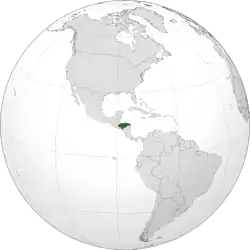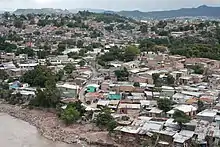

Squatting in Honduras is the occupation of unused land or derelict buildings without the permission of the owner. As the population of Honduras grew from the 1960s onwards, peasants occupied land. The Government of Honduras responded by giving peasants title to land and deporting Salvadoran migrants. The measures had limited success and in the 2010s, squatters continued to self-organise land invasions. The indigenous Miskito people are affected by squatters who practice illegal logging and drugs trafficking.
History
The population of Honduras rose to almost 2 million people by the 1960s and was boosted by 300,000 migrants from El Salvador, causing peasants in need of land to start squatting.[1] The Government of Honduras responded with various measures giving peasants title to land, so that up to 1975, 120,000 hectares were given to 35,000 households.[2] Salvadoran migrants were deported and this contributed to the outbreak of the Football War in 1969.[3]
Until the 1980s, there was little large-scale agriculture and most land was used by subsistence farmers or small coffee producers. In 1980, an estimated 75% of farmers did not own the land they were farming. Decree number 78 or the "Coffee Enterprise Protection Law", was introduced in 1981 as part of a plan by the government to regularize land titles which had limited success.[4]
In 1996, the Honduran Army evicted squatters from land at Tacamiche, south of San Pedro Sula, which belonged to Chiquita Brands International, the banana distributors. The 400 peasants had occupied the land since 1994, when Chiquita closed down the farm.[5]
2010s
On International Peasant Day of Struggle in 2012, 3,500 peasant families squatted land across the country in a co-ordinated protest. They occupied areas in eight provinces and claimed they could grow food on them because they were publicly owned, whereas the National Agrarian Institute said it owned the land and blamed insurrectionary attitudes. A former sugar plantation near to the capital Tegucigalpa was quickly evicted without violence and Via Campesina stated the occupations were peaceful.[6] Around Trujillo, Garifuna people squat land owned by foreigners and are evicted by the Army.[7]
The indigenous Miskito people on the Caribbean coast asked for help in 2015, after a spate of land invasions by loggers and drugs traffickers. These squatters chopped down trees and build airstrips for transporting drugs.[8] After a 25 year campaign, the indigenous peoples of La Mosquitia gained title to their lands in 2012. Fifty communities stretched along the coast were recognised as owners of 14,000km² of land.[9] In Roatán, an island lying north of Honduras, confusion over land titling led to squatters confronting the authorities in 2018.[10]
References
- ↑ Brondo, Keri Vacanti (6 June 2013). Land Grab: Green Neoliberalism, Gender, and Garifuna Resistance in Honduras. University of Arizona Press. pp. 35–36. ISBN 978-0-8165-9998-1. Archived from the original on 26 March 2021. Retrieved 26 March 2021.
- ↑ "USAID COUNTRY PROFILE PROPERTY RIGHTS AND RESOURCE GOVERNANCE HONDURAS" (PDF). Land-links. USAID. p. 5. Archived (PDF) from the original on 20 March 2021. Retrieved 15 March 2021.
- ↑ Luckhurst, Toby (27 June 2019). "Honduras v El Salvador: The football match that kicked off a war". BBC News. Archived from the original on 12 December 2020. Retrieved 26 March 2021.
- ↑ Montaner Larson, Janelle B.; Palaskas, Theodosios; Tyler, Godfrey J. (January 1999). "Land Titling and Technical Efficiency Among Small Coffee Producers in Honduras". Canadian Journal of Development Studies / Revue canadienne d'études du développement. 20 (2): 361–382. doi:10.1080/02255189.1999.9669836. PMID 21207881.
- ↑ Cuevas, Freddy (2 February 1996). "Honduran Army Evicts Peasants from Farm Owned By Chiquita". AP News. Archived from the original on 26 March 2021. Retrieved 15 March 2021.
- ↑ Staff writer (19 April 2012). "Thousands of Honduran workers occupy land". Al Jazeera. Archived from the original on 14 March 2021. Retrieved 15 March 2021.
- ↑ MacNeill, Timothy (1 September 2020). "Indigenous food sovereignty in a captured state: the Garifuna in Honduras". Third World Quarterly. 41 (9): 1537–1555. doi:10.1080/01436597.2020.1768840. S2CID 225651836.
- ↑ "Honduras Indians' land being seized by drug gangs and settlers, UN official says". The Guardian. AP. 10 November 2015. Archived from the original on 26 March 2021. Retrieved 15 March 2021.
- ↑ Munguía, Osvaldo. "Indigenous land rights in Honduras". Tearfund. Archived from the original on 20 January 2021. Retrieved 15 March 2021.
- ↑ Haylock, Keena (11 October 2018). "Up in Flames". PÄYÄ The Roatan Lifestyle Magazine. Archived from the original on 25 October 2020. Retrieved 15 March 2021.
Further reading
- Casad, Robert (1 January 1974). "Expropriation Procedures in Central America". International Lawyer. 8 (2): 316.

